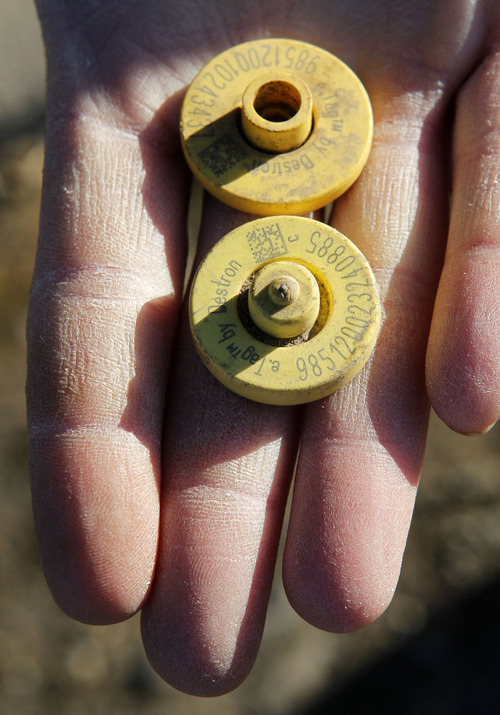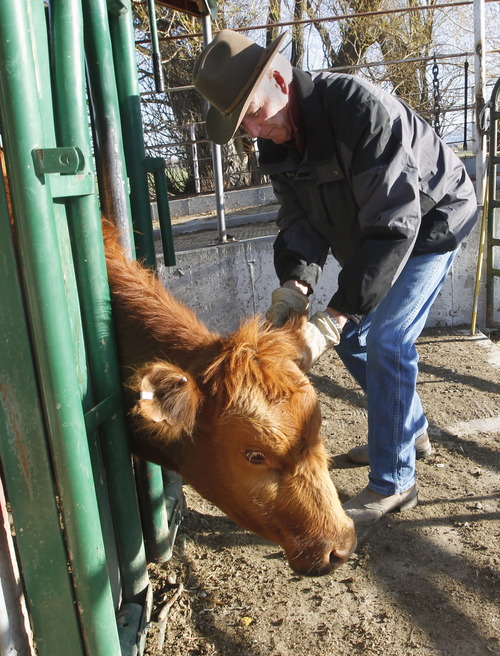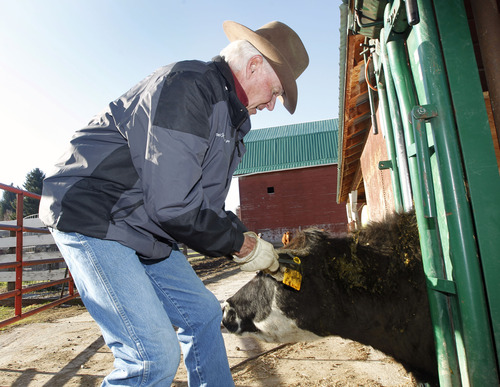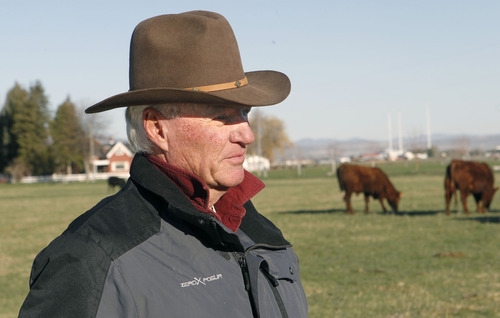This is an archived article that was published on sltrib.com in 2013, and information in the article may be outdated. It is provided only for personal research purposes and may not be reprinted.
The federal government has launched a mandatory livestock identification program to help prevent the spread of disease among dairy and beef cattle.
The identification system doesn't go so far as tracing food from farm to plate, as envisioned by some consumer advocates. But it does track animal movements across state borders, enabling agriculture and health officials to quickly trace disease outbreaks in livestock and establish quarantines.
"The program is only a first step in what likely will be a more comprehensive system that eventually will be able to quickly track all diseased animals," said Warren Hess, assistant state veterinarian for Utah. "But at this point, it only affects a fraction of the number of animals that are shipped out of Utah."
The program is mandatory, but limited in scope for many Utah ranchers, whose cattle may not fall under the rule, which went into effect March 11.
The new standards, require dairy cows and sexually intact beef cattle over 18 months of age to be registered when they are shipped over state lines. Utah ranchers, however, typically ship out younger calves and neutered steers for slaughter.
Other rules are still being worked out, giving Utah a temporary reprieve as it and other states develop the technology for tracking individual animals headed to the nation's food supply. But eventually, market shifts are likely to force changes for most Utah cattle producers.
Today, western ranchers brand their cattle, while many other states use ear markers or electronic tags to keep track of individual animals.
For now, federal rules allows states to agree on alternative forms of identification — such as brands — for animals shipped between them. Hess said Utah has worked out verbal agreements with surrounding states that rely on brands, such as Nevada, Wyoming, Colorado and Arizona.
But he added that other states — including some of the nation's largest beef cattle producers — are unlikely to enter into agreements that allow brands, which can specify the farm the animal came from but doesn't allow individual animal tracking.
Texas — the nation's largest cattle producer — already registers and tracks individual cattle, as do several Midwestern states where Utah ranchers often ship their cattle for fattening and slaughter.
Utah rancher Joe Fuhriman said he's uneasy about the federal government having access to information provided by producers. And he's worried that ranchers will be pressured to invest in electronic devices, which are cost prohibitive and cannot read cattle ear tags at a distance.
"They're improving on electronic identification tags," he said. "But the technology isn't quite there yet."
Brent Tanner, executive vice president of the Utah Cattlemen's Association, said state ranchers are moving toward tagging their cattle to show proof of testing or vaccinations. For instance, ranchers tag cows as part of a program to control brucellosis, a disease that can cause pregnant animals to miscarry.
Tanner said Utah ranchers understand the need to track diseased livestock, especially in light of several recent and damaging outbreaks.
Utah was among the top states in participation of a voluntary tracking program launched in 2006. About 64 percent of Utah ranchers signed up for the program, compared to one-quarter of producers nationwide. The federal government eventually scrapped the program because relatively few producers participated nationally.
State and federal officials point to a mad cow scare as another reason for an identification program.
By 2007, 25 countries shut off or threatened to close their markets to U.S. beef exports, resulting from a single cow in Washington State diagnosed with mad cow disease. It took investigators four months to track down all cattle that had come into contact with a the diseased cow — rather than 48 hours if a national animal identification tracking system had been in place.
Twitter@DawnHouseTrib —
Reading a cattle brand
Most brands or earmarks are letters, numerals or characters and are read:
Straight-away • From left to right
Stacked • From top to bottom
Outside in • When a character encloses another.
Source: Utah Department of Agriculture and Food —
Utah brands online
To register • Livestock owners must renew their brand or earmark every five years. Visit http://ag.utah.gov
Brand listings • Contains every registered brand and earmark, http://webapp.ag.utah.gov/brandWebApplication/
History • To research if an ancestor recorded a brand, visit http://archives.utah.gov/digital/540.htm —
Historical tidbits
Utah Territory • A law ordering printed brand books was passed in 1851 to prevent duplicate brands and to identify lost or stolen animals.
One early Utah brand • Despite his bluster, frontier marshal Orrin Porter Rockwell, who reportedly said, "I never killed anyone who didn't need killing," used the uninspired livestock brand OP.
U.S. brands • Most consist of capital letters, numerals and symbols, such as a slash, circle or bar. Amazingly, every number and letter of the alphabet can be made with an iron shaped in a J configuration.
Source: Utah Department of Agriculture and Food; Barb Wire Museum in Texas











